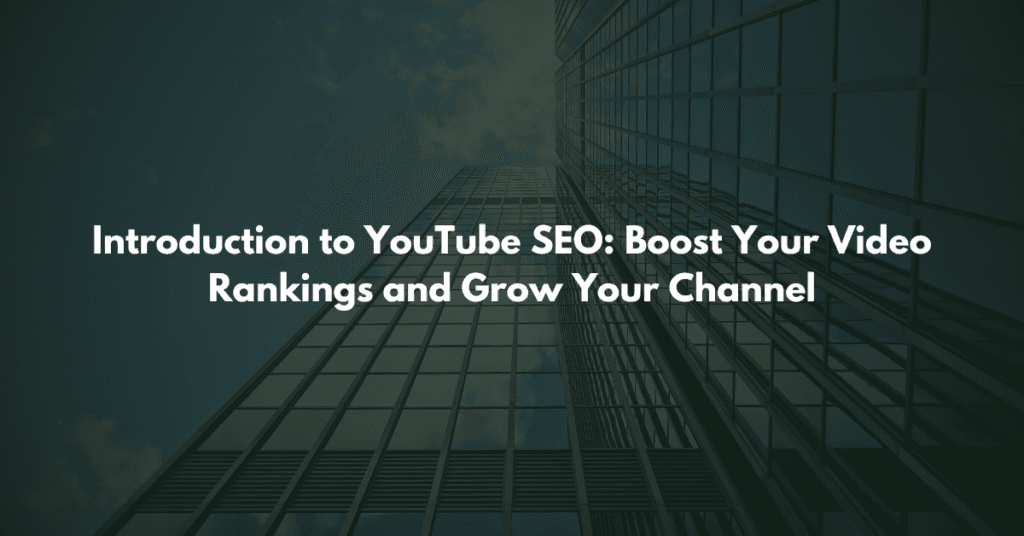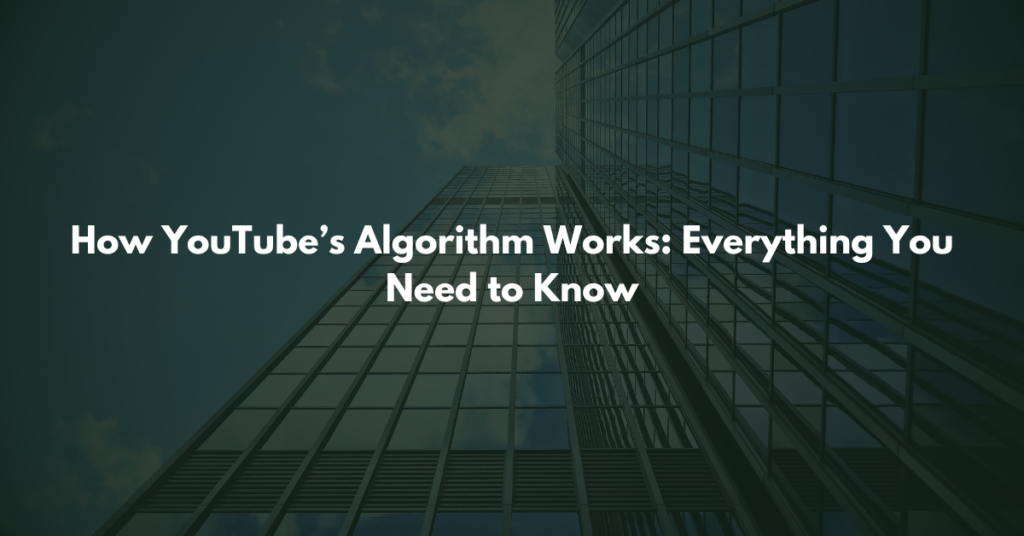YouTube has become one of the world’s largest search engines, second only to Google itself. With over 500 hours of video uploaded every minute, standing out on this platform can be challenging. That’s where YouTube SEO, or search engine optimization, comes in. YouTube SEO involves optimizing your videos to make them more discoverable by both viewers and YouTube’s algorithm. This helps your content rank higher, reach the right audience, and ultimately, grow your channel.
In this guide, we’ll cover everything you need to know to start optimizing your videos effectively, from understanding the basics of YouTube SEO to actionable steps for improving your rankings. Whether you’re a brand or an individual creator, this introduction to YouTube SEO will set you on the path to greater visibility and success.
What is YouTube SEO?
YouTube SEO is the process of enhancing various elements of your videos and channel to improve visibility and rankings in YouTube search results. Just like with Google SEO, the goal is to make your content appear higher on the list when users search for relevant terms. However, YouTube SEO includes unique aspects tailored to video content, such as optimizing video titles, descriptions, tags, and thumbnails.
In a nutshell, YouTube SEO is about aligning your content with what your audience is searching for. By doing so, you help YouTube understand and recommend your videos to the right viewers, giving your content the exposure it deserves. Understanding and applying these elements can make a significant difference in your video’s reach.
Importance of SEO on YouTube
YouTube SEO is crucial for anyone looking to grow on the platform, whether you’re a creator, business, or influencer. Effective SEO increases your chances of reaching a broader audience and enhances your content’s discoverability. Here’s why it matters:
- Standing Out in a Crowded Space
With millions of videos uploaded every day, your content needs to be optimized to rise above the noise. YouTube SEO helps your video rank higher in search results and suggests it to viewers interested in similar topics. - Building an Engaged Audience
When your content is discoverable and reaches the right audience, engagement improves, and you’re more likely to build a loyal subscriber base. YouTube rewards content that keeps viewers watching, and SEO plays a big role in achieving this. - Driving Organic Traffic
A well-optimized video brings in views organically, meaning that you can attract viewers without needing to rely on paid promotions. For businesses, this means a sustainable way to reach potential customers through quality content. - Supporting Long-Term Channel Growth
By following YouTube SEO best practices, your videos gain better visibility, creating a snowball effect. Over time, your content’s cumulative visibility can significantly boost your channel’s growth.
Key Elements of YouTube SEO
To improve your video rankings on YouTube, it’s important to understand the key elements of YouTube SEO. These elements not only help YouTube understand your content better but also make it more appealing to potential viewers.
1. Keyword Research for YouTube Videos
Like traditional SEO, keyword research is the foundation of YouTube SEO. Keywords tell YouTube what your content is about and help the algorithm match it with relevant searches. Start by identifying the keywords and phrases your target audience is likely searching for.
Use tools like TubeBuddy, VidIQ, or even YouTube’s own search bar to see popular suggestions for your topic. By incorporating these keywords naturally into your title, description, and tags, you increase your chances of ranking higher for those search terms.
2. Optimizing Video Titles
Your title is one of the first things viewers see, so it should be both informative and intriguing. Titles should include your main keywords and clearly reflect what the video is about. Aim for concise yet descriptive titles that spark curiosity without misleading the viewer.
For example, instead of “How to Bake,” consider a more keyword-rich title like “How to Bake a Perfect Chocolate Cake at Home.”
3. Crafting Compelling Video Descriptions
A well-written description helps YouTube understand your video content and increases your chances of ranking. Descriptions should include your primary keywords and offer a brief overview of what the video covers. Additionally, adding links to related content, timestamps for different sections, and social media links can make your descriptions more informative and useful.
For best results, aim for at least 150-200 words in your description, as this provides enough information for YouTube’s algorithm to analyze your video’s relevance.
4. Choosing Effective Tags
Tags are like supplementary keywords that provide context to your video. While they aren’t as critical as titles and descriptions, tags can still help your video appear in related searches. Use a mix of broad and specific tags related to your content, including keywords related to the main topic.
Avoid using irrelevant tags, as this can hurt your SEO. Stick to keywords that truly represent your video.
5. Eye-Catching Thumbnails
A compelling thumbnail is crucial for attracting viewers and increasing your click-through rate (CTR). Thumbnails should be visually engaging, relevant to your video, and include a clear image that reflects your video’s content. Adding a brief text overlay can also enhance its appeal, but avoid overcrowding.
6. Closed Captions and Subtitles
Captions and subtitles not only make your video more accessible but can also improve your SEO. YouTube can read the text in captions to understand your content better, increasing your chances of showing up in search results.
7. Engagement Metrics Matter
YouTube values engagement. Metrics like watch time, likes, shares, and comments signal to YouTube that your content is valuable. Encourage viewers to interact by prompting them to like, comment, and share your video. The longer people watch your videos, the better they perform in search results.
Steps to Implement YouTube SEO
Now that you know what factors into YouTube SEO, here’s a practical guide to getting started with optimizing your videos:
- Conduct Keyword Research: Identify primary and secondary keywords before filming. This allows you to structure your content around topics that interest your audience.
- Optimize Metadata: Incorporate keywords naturally in your title, description, and tags. Make sure these elements are aligned with what viewers will see in the video.
- Create Engaging Thumbnails: Design thumbnails that stand out in search results and attract clicks.
- Use Analytics to Adjust Strategy: Monitor your video’s performance using YouTube Analytics. Analyze CTR, audience retention, and engagement metrics to refine your strategy.
Common Mistakes in YouTube SEO
Avoid these pitfalls to ensure you’re setting your channel up for success:
- Keyword Stuffing: Overusing keywords can make your content look spammy. Aim for a natural flow.
- Ignoring Thumbnails and Descriptions: Skipping these elements reduces your chances of capturing attention.
- Neglecting Audience Engagement: SEO alone won’t make a video successful; focus on creating content that viewers want to engage with.
Analyzing YouTube SEO Performance
Tracking and analyzing your SEO efforts is essential to understanding what’s working and what isn’t. YouTube Analytics provides valuable insights on metrics like:
- Click-Through Rate (CTR): Indicates how compelling your thumbnail and title are.
- Audience Retention: Shows how long viewers stay engaged with your video.
- Watch Time and Views: Reflects your video’s popularity and relevance.
Use this data to make improvements on future videos.
Conclusion
YouTube SEO is a powerful tool for increasing your video visibility, reaching the right audience, and growing your channel sustainably. By following these best practices—from keyword research to optimizing titles, descriptions, and engagement—you’ll be well on your way to building a successful YouTube presence.
FAQs
1. What is YouTube SEO?
YouTube SEO is the practice of optimizing video content to improve its ranking on YouTube search results. This includes adjusting metadata, keywords, and engagement strategies.
2. How long does it take for YouTube SEO to work?
Results vary, but typically, it can take several weeks to see improvements in rankings. Regularly posting quality content helps to expedite growth.
3. Are keywords really important for YouTube SEO?
Yes, keywords help YouTube understand your content and match it with relevant searches, which can significantly impact visibility.
4. Do video tags still matter?
While tags are less critical than titles and descriptions, they still provide context and help YouTube associate your video with related topics.


